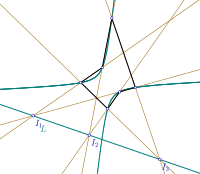Braikenridge–Maclaurin theorem


In geometry, the Braikenridge–Maclaurin theorem, named for 18th century British mathematicians William Braikenridge and Colin Maclaurin (Mills 1984), is the converse to Pascal's theorem. It states that if the three intersection points of the three pairs of lines through opposite sides of a hexagon lie on a line L, then the six vertices of the hexagon lie on a conic C; the conic may be degenerate, as in Pappus's theorem. (Coxeter & Greitzer 1967, p. 76). The Braikenridge–Maclaurin theorem may be applied in the Braikenridge–Maclaurin construction, which is a synthetic construction of the conic defined by five points, by varying the sixth point. Namely, Pascal's theorem states that given six points on a conic (the vertices of a hexagon), the lines defined by opposite sides intersect in three collinear points. This can be reversed to construct the possible locations for a sixth point, given five existing ones.
References
- Mills, Stella (March 1984), "Note on the Braikenridge-Maclaurin Theorem", Notes and Records of the Royal Society of London, The Royal Society, 38 (2): 235–240, doi:10.1098/rsnr.1984.0014, JSTOR 531819
- Coxeter, H. S. M.; Greitzer, S. L. (1967), Geometry Revisited, Washington, DC: Mathematical Association of America, p. 76